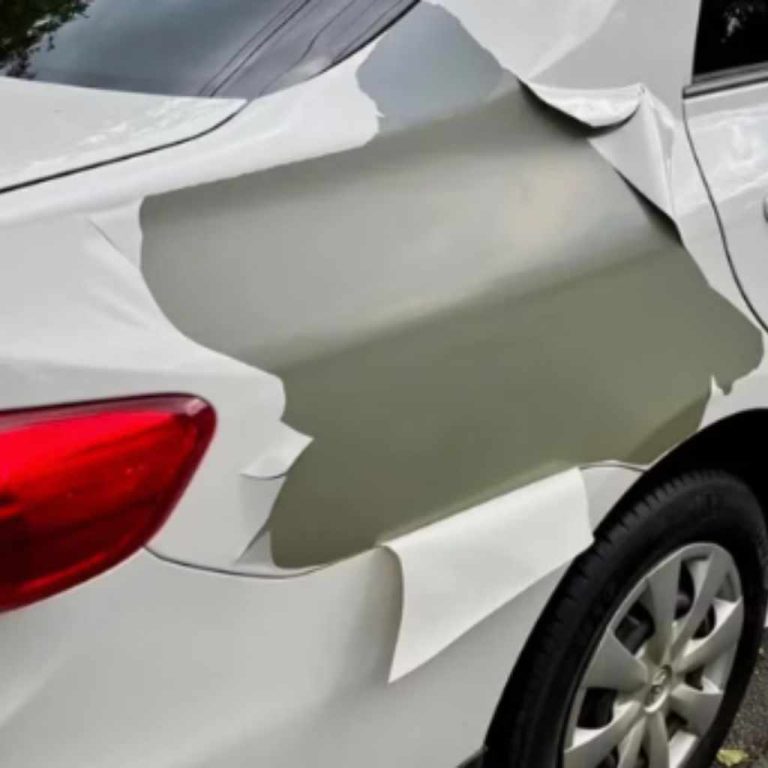How to Get a Ding Out of Car: Quick DIY Fixes!
To get a ding out of your car, use a hairdryer to heat the area for about 30 seconds. Then, cover the ding with aluminum foil and apply dry ice to create a popping effect that can remove the dent.
Dings and dents can happen to anyone, often leaving unsightly marks on your car’s exterior. These small imperfections can be frustrating, especially if you take pride in your vehicle’s appearance. Fortunately, there are effective methods to remove these minor dents without professional help.
Techniques range from using household items to specialized kits designed for DIY repairs. Understanding how to tackle these dents can save you money and time, allowing you to restore your car’s look with minimal effort. This guide will walk you through simple steps to fix those pesky dings and get your vehicle looking its best again.
Introduction To Car Dent Repair
Car dents can happen for many reasons. Parking lot accidents are a common cause. Shopping carts can also cause dents. Bad weather, like hail, can lead to dents too. Even minor collisions can leave marks on your car.
Prompt dent repair offers many benefits. It keeps your car looking newer and more appealing. Quick repairs prevent rust from forming. This helps maintain your car’s value over time. A well-maintained car can also improve safety. Ignoring dents can lead to more expensive repairs later.
Assessing The Damage
Identifying the types of dents is crucial for effective repair. Common types include:
- Crease Dents: Long, thin dents that are hard to remove.
- Round Dents: Circular dents from small impacts.
- Sharp Dents: Dents with edges that can damage paint.
- Large Dents: Bigger areas affected, often requiring professional help.
Recognizing when to call a professional is key. If the dent is deep or large, expert tools may be needed. Professionals can also fix paint damage effectively. For multiple dents, hiring a pro saves time and ensures quality. Safety should always come first, so don’t hesitate to seek help.
Tools And Materials You’ll Need
To remove a dent from your car, gather these essential tools:
- Rubber mallet for gentle tapping.
- Heat gun or hairdryer to warm the area.
- Plastic scraper to protect the paint.
- Pliers for pulling out stubborn dents.
- Denture repair kit or glue puller for better grip.
Safety is important during this process. Follow these precautions:
- Always wear safety goggles to protect your eyes.
- Use gloves to avoid cuts and scrapes.
- Ensure the area is well-ventilated when using heat tools.
- Keep flammable materials away from heat sources.
Plunger Method
First, clean the area around the dent. Make sure it is dry. Next, get a cup-style plunger. Press the plunger onto the dent. Use firm pressure. Pull the plunger back quickly. Repeat if needed. Check the dent. It should look better.
- Use a clean plunger.
- Work in a warm environment.
- Be patient.
- Try multiple times if needed.
- Check for any remaining dents.
Boiling Water Technique
Start by cleaning the area around the ding. Use soap and water to remove dirt. Dry the area with a soft cloth. Next, gather your materials: a kettle, water, and a plunger. Boil enough water to fill the kettle.
Carefully pour the boiling water over the ding. Ensure the water covers the dent completely. This will make the metal more flexible. After pouring, immediately use the plunger. Push and pull gently to pop the ding out.
Be careful with the boiling water. Avoid any contact with skin. Always wear heat-resistant gloves for safety. Make sure to work in a well-ventilated area.
Using A Dent Puller
Choosing the right dent puller is essential for effective ding removal. Various types exist, such as suction cup, slide hammer, and hot glue pullers. Each type serves a specific purpose.
Suction cup pullers are great for shallow dents. They are easy to use and effective on smooth surfaces. Slide hammer pullers work well for deeper dents. They provide more pulling power and are versatile.
Hot glue pullers require glue and a special tab. This method works for many dent sizes. Select a puller based on the dent’s depth and location. Always follow the manufacturer’s instructions for the best results.
Applying A Diy Dent Repair Kit
Using a DIY dent repair kit offers both benefits and drawbacks. Pros include cost-effectiveness and convenience. Kits are often easy to use for small dents. They allow quick repairs at home, saving time.
On the downside, cons may involve limited effectiveness on larger dents. Results can vary based on skill level. Some kits may not work well with all car paints. Improper use can lead to further damage.
| Pros | Cons |
|---|---|
| Cost-effective | Limited effectiveness on large dents |
| Convenient | Varied results based on skill |
| Easy to use | Possible damage to paint |
| Quick repairs |
Finishing Touches
After fixing the ding, sanding is important. Use fine-grit sandpaper to smooth the area. Start with a light touch. Gradually increase pressure as needed. This helps blend the repair with the rest of the car.
Repainting follows sanding. Choose a paint that matches your car’s color. Apply thin layers for an even finish. Allow each layer to dry before adding more. This prevents drips and uneven color.
Next, polish the affected area. Use a soft cloth and a good polishing compound. This step brings back the car’s shine. Buff the area gently to avoid scratches. The final result should look smooth and new.
Preventive Measures For The Future
To prevent dents, follow these parking tips:
- Always choose well-lit parking spots.
- Park away from high-traffic areas.
- Use corner spots to avoid door dings.
- Check for overhanging branches before parking.
Consider using these protective accessories for your car:
- Car covers can protect against scratches.
- Door edge guards help prevent door dings.
- Bumper protectors reduce damage from minor impacts.
- Parking sensors can help avoid obstacles.
Conclusion: Maintaining Your Car’s Aesthetics
The value of a dent-free car cannot be overstated. A smooth exterior enhances the overall aesthetic appeal. It also helps maintain the vehicle’s resale value. Buyers often prefer cars without dents. Investing in dent repair can save money in the long run.
When to revisit dent repair is important for car owners. Regular inspections can help spot new dents early. Prompt repairs prevent further damage to the paint. Keeping your car looking its best requires attention and care.
| Reason to Repair Dents | Benefits |
|---|---|
| Improved Appearance | Boosts overall look and feel of the car |
| Higher Resale Value | Attracts more buyers when selling |
| Preventing Rust | Stops further damage to the car’s exterior |
Frequently Asked Questions
How Can I Remove A Ding From My Car?
You can remove a ding using methods like a hairdryer, dry ice, or a suction cup. Heat the area with a hairdryer, then quickly apply dry ice. Alternatively, use a suction cup to pull the dent out. These methods work best on small dings.
Is It Safe To Use A Hairdryer On My Car?
Yes, using a hairdryer on your car is safe if done correctly. Ensure the heat is on a low setting to avoid paint damage. Keep the dryer moving to distribute heat evenly. Always maintain a safe distance to prevent overheating any specific area.
What Tools Do I Need For Ding Removal?
Essential tools for ding removal include a hairdryer, dry ice, and a suction cup. A dent repair kit may also be helpful, containing specialized tools. These items are often available at auto parts stores. Always follow safety precautions when using these tools.
Can I Fix A Ding Without Professional Help?
Yes, many small dings can be fixed without professional help. DIY methods are often effective for minor dents. However, larger dings may require professional assistance. Assess the damage first to determine the best approach for your situation.
Conclusion
Removing a ding from your car doesn’t have to be a daunting task. With the right tools and techniques, you can restore your vehicle’s appearance effectively. Whether you choose DIY methods or professional help, maintaining your car’s look is essential.
Keep your ride looking its best for years to come.





